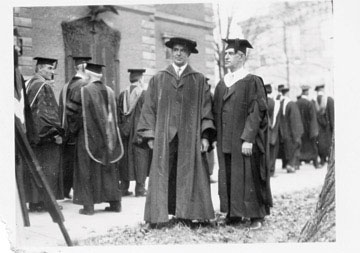by Elizabeth Swift, Wabash Archivist
 | |
|
Dartmouth President Ernest Hopkins at the inauguration of his brother, Louis, as President of Wabash. |
The Wabash—Dartmouth College connection has been both long and deep. Both Caleb Mills and Edmund O. Hovey were Dartmouth alumni, as was our second president, William White. But an even closer connection—that of the Hopkins brothers—was so unusual that it drew national press coverage.
Louis Bertram Hopkins was the seventh president of Wabash College. His older brother Ernest was the president of Dartmouth. At the inauguration of President Louis Hopkins, the principal speaker was President Ernest Hopkins of Dartmouth. In a scrapbook in the Archives of Hopkins’ inauguration are articles from several newspapers and a clipping from the TIME Magazine of December 13, 1926.
Ernest M. Hopkins was a much beloved president of his alma mater from 1916 until 1945. The fine arts building at Dartmouth was named the Hopkins Center in his honor. At the dedication of this building in 1962, New York Governor Nelson Rockefeller, a member of the Class of 1930, turned to Ernest Hopkins and said, “I came to Dartmouth because of you.”
Louis followed Ernest to college, but when funds ran out, had to leave school and go to work. He became a successful businessman and was given an honorary masters degree by Dartmouth in 1925. When recruited for the Wabash presidency, Louis Hopkins was at Northwestern University as its Director of Personnel.
Hopkins’ presidency marked the beginning of the modern Wabash College. He was the first non-minister to rise to the presidency, and under his direction, athletics were returned to true amateur status and academics were given more attention.
As President Andy Ford said in the Fall/Winter 1999 Wabash Magazine: “Without Hopkins’ forceful leadership the College would not have emerged in the second half of this century as a highly respected residential liberal arts college worthy of national attention.”
Indeed, Hopkins’ plan for Wabash received at that time national attention. It was published in a small book entitled Five College Plans. He was asked to speak across the nation on this new, modern approach to a liberal arts education. The divisional system and comprehensive exams are two of his lasting contributions.
I am often struck by another of Hopkins’ contributions—the design